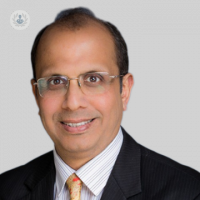Gallstone surgery: What you need to know
Escrito por:
Gallstones are a common yet often painful condition that can lead to a range of symptoms and complications. When gallstones cause significant problems, gallstone surgery (a procedure known as cholecystectomy) is often the recommended treatment.
Mr Sanjay Agrawal, renowned consultant surgeon, provides an expert overview of gallstone surgery, discussing the preoperative tests involved, the details of the surgical procedure, and the expected recovery process.

Why would I need gallstone surgery?
Gallstones are hardened deposits of digestive fluid that form in the gallbladder, a small organ under the liver. They can vary in size and cause various symptoms and complications.
Surgery for gallstones is recommended:
- When gallstones cause pain (biliary colic) due to obstruction of the bile ducts.
- When there is inflammation of the gallbladder (cholecystitis), often caused by gallstones blocking the cystic duct.
- When gallstones block the pancreatic duct, leading to inflammation of the pancreas (pancreatitis).
In these cases, surgically removing the gallbladder (whether performed laparoscopically or through open surgery) is often the best treatment to alleviate symptoms and prevent further complications.
What preoperative tests are done before gallstone surgery?
Before undergoing gallstone surgery, several tests are conducted to ensure that the patient is a suitable candidate for the procedure and to plan the surgery effectively. These preoperative tests include:
- Blood tests: Blood tests are performed to check for infection, liver function, and the patient’s overall health status.
- Abdominal ultrasound: An abdominal ultrasound is the primary imaging test to detect gallstones and assess the condition of the gallbladder.
- MRI or CT scan: Detailed imaging tests like MRI or CT scans are used to get a better view of the bile ducts and surrounding structures.
- Electrocardiogram (ECG): An ECG is carried out to evaluate heart health, especially for older patients or those with existing heart conditions.
- Chest X-ray: A chest X-ray is performed to check lung health and detect any underlying conditions that could affect anaesthesia.
How is laparoscopic gallstone surgery performed?
Gallstone surgery can be performed using two main techniques: laparoscopic surgery and open surgery. Laparoscopic cholecystectomy is the most common method. It is a minimally invasive procedure with several benefits, including shorter recovery time and less postoperative pain. The patient is given general anaesthesia, ensuring they are asleep and pain-free throughout the surgery.
During laparoscopic gallstone surgery, the surgeon makes four small incisions in the abdomen. These incisions are usually less than an inch long: one incision is made near the belly button, and the other three incisions are made in the upper right part of the abdomen.
A laparoscope, which is a thin tube with a high-resolution camera and light at the end, is then inserted through the incision near the belly button. The laparoscope sends real-time video images to a monitor, giving the surgeon a clear view of the gallbladder and surrounding organs. In addition, carbon dioxide gas is also pumped into the abdominal cavity to inflate it. This creates more space for the surgeon to work and provides a better view of the organs.
The surgeon introduces specialised surgical instruments through the remaining incisions. Using these instruments, the surgeon carefully separates the gallbladder from the liver and the bile ducts. This process involves clipping and cutting the cystic duct (which connects the gallbladder to the common bile duct), clipping and cutting the cystic artery (which supplies blood to the gallbladder), and dissecting the gallbladder from its attachments to the liver.
Subsequently, the detached gallbladder is placed in a retrieval bag and removed through one of the incisions, typically the one near the belly button. The surgeon also removes the laparoscope and the surgical instruments, and the carbon dioxide gas is released from the abdominal cavity. The small incisions are closed with sutures (stitches), surgical staples, or adhesive surgical tape and sterile dressings are applied to the incision sites.
Lastly, the patient is taken to a recovery room where they are monitored as the anaesthesia wears off. Vital signs, such as heart rate, blood pressure, and oxygen levels, are closely observed, and the patient is given pain medications to manage any discomfort.
Is gallstone surgery safe?
Gallstone surgery, particularly laparoscopic cholecystectomy, is generally considered safe. Nevertheless, like all surgical procedures, it entails certain risks. Common risks and complications include:
- infection, at the incision sites or internally
- bleeding, during or after the surgery
- bile duct injury, requiring further surgery
- adverse reactions to the anaesthesia, including allergic reactions
- postoperative blood clots in the legs or lungs
Despite these risks, complications are relatively rare, and the benefits of surgery often outweigh the potential risks.
How soon can I return to my daily activities?
Recovery time after gallstone surgery varies, depending on the type of surgery performed and the patient's overall health.
Generally, with laparoscopic gallstone surgery, most patients go home the same day or the day after surgery. Usually, patients can resume light activities within a few days. Most patients can return to work within a week, especially if their job is not physically demanding. However, strenuous activities should be avoided for at least 2 to 4 weeks to allow healing.
Will I have dietary restrictions after gallstone surgery?
Most patients can return to their regular diet after gallstone surgery, but some dietary adjustments may be necessary, especially in the early stages of recovery. These might include:
- Low-fat diet: Immediately after surgery, a low-fat diet is often recommended to reduce the workload on the digestive system.
- Small and frequent meals: Eating frequent small meals can aid in digestion and alleviate discomfort.
- Hydration: Staying well-hydrated is important for overall recovery and digestive health.
Long-term, most patients can return to a normal diet without significant restrictions. However, some patients may continue to experience digestive issues, such as diarrhoea or bloating, and might need to avoid certain foods that trigger symptoms. For this reason, patients are recommended to slowly reintroduce high-fat foods to see how their body tolerates them.
If you would like to schedule an appointment with Mr Sanjay Agrawal, head on over to his Top Doctors profile today.


